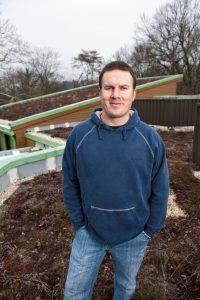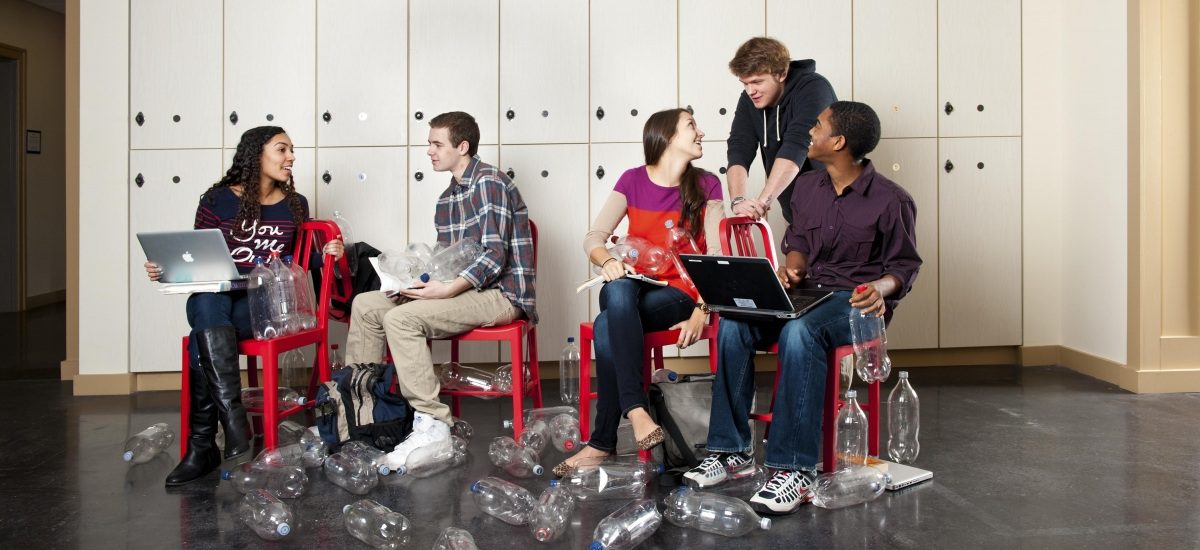Sustainability is a puzzling concept to many. In its simplest form, it’s a movement to preserve the Earth’s natural resources. Some like its cost-saving benefits; others appreciate how it improves our quality of life. In SJ, many towns and businesses are bringing the fairly new concept to life, introducing smart actions to better the world around us.
The chairs in the student lounge of the newest building at Moorestown Friends School aren’t just chairs. They are statements about the Earth’s future.
“The chairs are recycled soda bottles. They are more expensive, but it’s a good way to model a sustainable approach,” school head Larry Van Meter says.
The chairs, each made of 111 two-liter Coke bottles, are a microcosm of the whole building. Each part of the retrofitted Hartman Hall embraces sustainability, a concept that takes every avenue possible to preserve and protect the Earth’s natural resources.
“If you are going to do a green building, know from the very beginning, because it’s woven into all of the aspects,” says Van Meter. “We knew we were going to do this, because a Friends school believes in being good stewards of the Earth.”
Sustainability, as well as its cousins greening and eco-friendly, is a more concentrated effort than the occasional visit to a farmers’ market. It is the exacting, interwoven work of individuals, governments, schools and businesses and can be found in every corner of life.
“In addition to just being the right thing to do, sustainability has real, tangible benefits: economic growth, improved public health, a higher standard of living and, of course, there are financial savings,” says Cherry Hill Mayor Chuck Cahn.
Sustainability can be overwhelmingly intangible. It is usually visualized as three large interlocking rings, each with a single word – “environment,” “social” and “economic” – tucked inside. The circles overlap to show what is bearable, equitable and viable to survive. At the core, it is sustainable. This is the map to sustainable living. Putting it into practice can be a balancing act, but many are trying.
“Many define Al Gore’s movie ‘An Inconvenient Truth’ as a turning point,” says Camden County Freeholder Jeff Nash. “Many activists became involved and the community started to demand it. It was an important social issue.”
Those at Moorestown Friends School considered revamping a former nursing home annex into sustainable Hartman Hall a no-brainer. But it did present a different set of challenges than the standard destruction and design of a new building.
“It was easier – and harder,” says Van Meter. “It may have been easier to start from scratch, but the building material would have to be discarded and new material purchased, which is wasteful.”
Hartman Hall, from its math classrooms to its choral suite to its tech lab, is filled with purposeful decisions. Instead of new tile, the concrete floors were polished and stained. The existing geothermal cooling and heating system was enlarged and uses 20 percent less energy than a more traditional method. Low- or no-volatile organic compounds were the only choices for the interior. There were no afterthoughts.
“The more natural light there is, the less artificial light is needed. We made the windows larger and well-insulated for a better thermal barrier,” says Van Meter. “Should the building have screens? Sounds inconsequential, but we decided when the nice weather came we wanted to be able to open the windows and have the heating and cooling systems not operate at all.”
Harvesting the outdoors is the first step for many sustainers. Throwing open the drapes or hanging a laundry line is the home version of the solar panels that are popping up everywhere, like tulips in spring.
Gloucester County was first to take the sun to the streets. A solar-powered traffic signal debuted in 2011 outside the Timber Creek Shopping Center in Mantua Township. No light had existed at the spot before, but the rules of the road were already clear.
“We need the panels to be in a good area for optimum operation. They are on top of the signal poles,” says county Freeholder Heather Simmons. “The signals are still connected to the grid, but they have battery backup.”
The panels collect rays throughout the day and funnel them back into the system. That one light saved the township between $450 and $550 in its first year of existence, cutting the township’s electric bill from $60 to $10 a month. Multiply that dollar amount by the 24 flashing lights and eight full signals now installed and the 20 more coming for this year, and the number hits the tens of thousands.
“This helps reduce our need for power while reducing costs,” says Simmons. “People see them and they have the feeling if something can be done, it’s being done.”
Solar panels can be found in Cherry Hill, as well. There are 444 large panels atop the Public Works building and 128 perched on the roof of Town Hall. The Public Works array and its 100 kilowatts went online in 2010, while the Town Hall project, which generates 30 kilowatts, was completed in October of last year.
“The Town Hall subsidizes 11.5 percent demand during peak hours and Public Works subsidizes 100 percent,” says mayoral aide Bridget Palmer.
Cherry Hill does not just look up when it comes to sustainability. It looks down – down on the ground and down in to the water.
A smoking ban, adopted in November, restricts puffing on all public land, like parks and playgrounds. Health and litter prevention were the ban’s dual purpose, says Palmer.
“People often think of sustainability solely as an environmental effort. I prefer to take a more holistic approach,” says Cahn. “I believe that to be a truly sustainable community we must think in terms of not just the environment, but of the state of our local economy and the overall well-being of our citizens as well.”
Many, like Cahn, believe sustainability goes hand-in-hand with health and wellness. Farm-fresh foods and “outdoors” that are more than trudging from the house to the car to a building can make for a deeper connection to the Earth. The “outdoors” should have parks with walking and biking trails. They should look inviting, burst with flora and fauna, and feel vibrant.
Camden County put the Open Space, Recreation, Farmland and Historic Preservation Trust Fund Referendum to the voters in the late 1990s. The environmental movement was in its toddler stage, not quite brand-new but nowhere close to standing on its own.
“The referendum was originally defeated, but it came back the next year and was overwhelmingly approved,” says Nash. “The first year, there was little education about it. When it was defeated, there was an educational effort and it turned around dramatically.”
Up to two cents of each tax dollar collected went to the fund. Since then, the millions generated have preserved about 2,000 acres as greenways, farms, parks and trails.
“It terms of sustainability and open space, it’s an enormous benefit to the county and the community. The government’s job is to make people safe and ensure their quality of life. Open space does that,” says Nash.
Pulling every aspect of a sustainability effort together, such as a land purchase, can be a juggling act of grand proportions even if all of the parties involved are on the same page. There needs to be one foot in the present and one foot in the future. The next step, Camden County found, was to create and hire someone to fill that role.

Director of Sustainability Chris Waldron is leading Camden County’s sustainable practices
“In 2011, we realized we needed to do more. We achieved many goals, but we were now approaching 2012, and we needed a new plan. That’s when we hired Chris Waldron,” says Nash.
Waldron spent five of his 18 years at the Philadelphia Zoo as its sustainability manager. He took the newly created position as the county’s director of sustainability in June.
“It’s different and not different. My background is a degree in wildlife and fisheries science. For a long time, I’ve had an interest in sustainability. It’s the way we live our lives,” says Waldron, who works with each agency and municipality to create a uniform sustainability vision for the county.
Waldron’s post is not the only new, large-scale addition to the area’s sustainability movement. Both Gloucester and Camden Counties have found new avenues for their ideas.
Gloucester County will say goodbye to two 2006 Ford buses that do not meet federal emissions standards and say hello to two compressed natural gas vehicles. Camden is planning to put in 10 electric vehicle charge stations throughout the county. Both will become realities this year.
Compressed natural gas is a mostly methane alternative fuel that burns cleaner than gas or diesel, according to the Environmental Protection Agency (EPA). Odorless, colorless and tasteless, it is drawn from gas wells or in conjunction with crude oil production, says the EPA. Gloucester County officials plan to use the buses for the Senior Transportation Program, which hits more than 25,000 miles annually during its 69,000 rides per year.
“The cost to run these buses can be 40 percent less than those with fossil fuel. They can reduce carbon monoxide emissions by 90 percent per vehicle,” says Simmons.
While compressed natural gas is one frontier, Camden County is going for the electric ride. The plan is to place chargers in communal locations, like libraries and colleges. The idea is that people will spend enough time at these locales to properly zap their wheels.
“You’ll start to see more and more electric cars. It will be a battle between them and the oil companies,” says Nash. “It’s evolving. The world cannot sustain on gas-fueled cars. It will lead to alternative forms of travel.
“Everyone understands the global-warming crisis. This will affect us, but people need to know what they can do,” says Nash. “If you close your eyes, when we started recycling in the 1980s, it was a foreign concept. You open your eyes today and if you are not recycling, it’s not the norm.”














